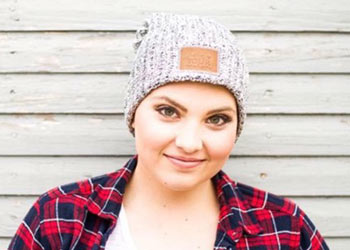
By Amy Fair, Childhood Cancer Survivor & CureSearch Volunteer
I didn’t get to have the traditional high school experience. While my friends were at soccer practice and school dances, I was in the hospital receiving chemotherapy or recovering from the effects it had on my body. When I was 15, I was diagnosed with leukemia and spent two and a half years in and out of the hospital. But I was one of the “lucky” ones because I had a type of childhood cancer with a high success rate. However, that success rate doesn’t take into account the long-term effects cancer and toxic chemotherapy can have on a child’s growing body. In fact, the majority of childhood cancer survivors suffer from serious lifelong side effects including hearing and vision problems, heart issues, and even secondary cancers.
Within my first month of treatment, I suffered a stroke from one of the chemotherapy drugs. It affected the right side of my body, so I had to re-learn how to do everyday activities like walk, write, and tie my shoes. I feel naïve in saying this, but no one said the word “stroke” to me at the time and I think I would have panicked if they had. I hadn’t put together that that’s what had happened to me. In my mind, strokes only occurred in the elderly. I didn’t realize they could happen to anyone.
The stroke caused me to have focal seizures that affected my right arm when I was a teenager. I took medicine and they remained under control. Fast forward 19 years to when I became a full-blown epileptic. I have regular focal seizures and am constantly concerned about having another grand mal seizure. My neurologist tells me I essentially have a bruise on my brain from the cancer treatment I received, and that it causes the neurological impulses to misfire. It will never go away.
I am so thankful for incredible organizations like CureSearch for Children’s Cancer. Due to their diligent work, I, along with many others, am still here today. But it is vital that more research be done to reduce the long-term effects of chemotherapy on childhood cancer survivors. Again, I am one of the “lucky” ones who survived my stroke and my treatment. Many don’t know the warning signs or ignore them not believing they could possibly be having a stroke. These signs cannot be ignored.
October 2021 will mark 25 years since my stroke and I know that I am truly lucky – without the quotes around it – to be able to say that.
To learn more about childhood cancer statistics, survival rates, and long-term effects, visit curesearch.org/childhood-cancer-statistics
###
About CureSearch
CureSearch for Children’s Cancer works to end childhood cancer by driving targeted and innovative research with measurable results in an accelerated time frame. CureSearch focuses on advancing the strongest research out of the laboratory and into clinical trials and development, where better, less-toxic treatments can quickly help children.
For more information, visit curesearch.org, follow CureSearch on Twitter @curesearch or join the conversation on Facebook at facebook.com/curesearch.



